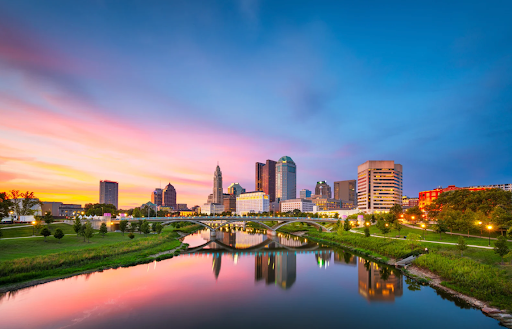As summer fades and temperatures drop, commercial properties need special care to survive winter and look healthy and well-kept in spring. This article for the fall season helps you cover all key tasks so your property stays healthy, safe, and attractive through the colder months.
Whether you manage an office campus, retail center, industrial park, or multi‑tenant building in Northeast Ohio, this fall season landscaping checklist for commercial properties is your roadmap to an organized, effective autumn. If you need professional help, feel free to call Unique Landscaping today at (440) 888-1884.
Checklist for Commercial Fall Landscaping
Here are the core components of your fall plan, with details and pro tips tailored to commercial properties in Northeast Ohio.
1. Leaf Cleanup & Debris Removal
Commercial properties often have large landscape areas or mature trees. Fallen leaves pile up fast. Remove leaves from turf, beds, curbs, and hardscape surfaces.
Pro Tip: Use blowers, vacuums, or dragging systems. Don’t let leaves sit in islands or corners. Build-up of moisture and shade under leaves leads to disease and turf damage.
2. Aerate & Overseed
Aeration (drill holes in the soil) loosens compacted soil so water, air, and nutrients reach roots. After aeration, overseed thin or bare patches.
Pro Tip: Use a core aerator. For overseeding, pick a seed mix suited for commercial use. Water gently until established.
3. Fertilization & Soil Nutrients
Apply a fall fertilizer or soil amendment. Commercial properties benefit from root‑oriented formulations with potassium or phosphorus.
Pro Tip: Test the soil if you can. Commercial lawns often get packed down and lose nutrients because of all the foot traffic, equipment, and regular use.
4. Shrub, Tree, & Perennial Maintenance
Trim dead branches, remove diseased growth, and shape shrubs. Thin out perennials and remove spent foliage.
Pro Tip: Avoid heavy pruning of spring‑blooming shrubs (they’ve already set buds). Leave ornamental grasses or seed heads for winter where appropriate.
5. Seasonal Color & Plant Rotation
Replace summer annuals with fall colors like mums, pansies, or ornamental kale. Add fresh fall color near entrances and signs to keep your property looking welcoming and well-maintained.
Pro Tip: Choose hardy varieties suited to Ohio’s frost periods.
6. Mulch & Bed Protection
Reapply 2–3 inches of mulch to garden beds to protect roots and block the growth of weeds. Pull any existing weeds and clean up the bed edges for a neat look. Avoid overmulching because it can suffocate the plants, and less mulching offers little insulation.
Pro Tip: Don’t pile mulch against the trunk or stems. Use clean bark or hardwood mulch that resists compaction.
7. Inspect and Winterize Irrigation & Sprinkler Systems
Commercial sites often have complex irrigation zones. Before winter, shut off systems, drain lines, or blow out pools of water with compressed air to prevent freezing damage.
Pro Tip: Check for broken pipes, leaks, or valve issues. Fix them before winter so they don’t worsen or lead to costly spring repairs.
8. Hardscape & Pavement Maintenance
Inspect sidewalks, parking lots, curbs, retaining walls, and pathways. Clean debris, remove weeds, fill cracks, and seal surfaces if needed.
Pro Tip: Fall is ideal to seal asphalt and repair cracks before winter’s freeze‑thaw cycles cause worse damage.
9. Gutter, Drainage & Runoff Management
Clear gutters, downspouts, and storm drains. Ensure water flows away from foundations and landscaped zones.
Pro Tip: Add extensions or a hard pipe to direct water away. Check for low spots where water can pile up and freeze.
10. Snow & Winter Prep (Commercial Focus)
Plan snow removal paths, store snow equipment, and protect vulnerable structures. For properties with large open areas, consider snow fencing or windbreaks.
Pro Tip: Wrap vulnerable shrubs, use anti‑desiccants on evergreens, and coordinate with snow contractors ahead of time.
11. Facility Signage & Entrances
Ensure entrance signage, planter beds, and landscape near walkways are well-maintained and visible.
Pro Tip: A well‑lit and clean entry zone reflects well on your brand.
12. Equipment & Tool Maintenance
Clean and take care of your tools like trimmers, blowers, and irrigation equipment. Empty the fuel, sharpen the blades, and store everything in a dry place for winter.
Pro Tip: Keep spare parts handy in early fall; ordering parts midwinter can be delayed.
13. Audit & Plan for Next Season
Walk around the property and note weak areas, pest or disease spots, and enhancement ideas. Sketch plans and schedule early projects.
Pro Tip: Consult with your commercial landscaper now to lock in spring projects, pricing, and materials.
Why Fall Landscaping Matters for Commercial Properties in Northeast Ohio

Fall landscaping isn’t just a seasonal task. It’s a smart investment in your property’s health, safety, and curb appeal. In Northeast Ohio, where winters can be tough, taking a proactive approach during the fall helps businesses avoid future problems.
Here’s why it matters:
- Protects Your Landscape – Cooler weather gives turf, trees, and plants a chance to recover from summer stress and grow strong roots before winter.
- Prevents Winter Damage – Cleaning up leaves, trimming branches, and winterizing systems lowers the risk of snow and ice damage.
- Improves Safety – Clean walkways and prepped hardscapes reduce hazards like icy buildup or blocked paths during snowy months.
- Supports Brand Image – A well-kept property shows your business is organized, professional, and cares about first impressions.
- Reduces Future Cost – Fall work reduces the need for costly spring repairs or emergency landscaping. It’s preventive care that pays off later.
Even as the season winds down, customers, tenants, and visitors still notice your property. Keeping it clean and maintained reflects well on your business year-round. It also shows your team or tenants that you’re on top of maintenance, even in the off-season.
Common Challenges & Mistakes to Avoid
- Skipping Leaf Removal Too Long – Letting leaves sit leads to soggy lawns, mold, and grass suffocation. It’s cheaper to remove them early than to replace turf in the spring.
- Overlooking Drainage Issues – Pooled water near buildings or in planting beds can lead to root rot or foundation damage. Fall is your last chance to redirect runoff before snow hits.
- Delaying Pruning or Doing It Too Aggressively – Light pruning is helpful, but cutting back too much in the fall can expose plants to cold stress or damage new growth already set for spring.
- Forgetting to Shut Down Irrigation Systems: Failing to blow out sprinklers or shut valves can lead to frozen pipes and costly breaks. Always winterize early in Ohio’s unpredictable fall.
- Ignoring Hardscape Maintenance: Cracked sidewalks or uneven pavers become dangerous once snow and ice arrive. Fall inspections help reduce liability and repair costs.
- Not Planning for Spring Projects Now: Fall is when smart property managers plan early spring upgrades, securing vendors before their schedules fill up. Waiting until March is often too late.
Handling these well separates good commercial property management from excellent maintenance.
Your Fall Landscaping Action Plan
Fall is a key season when well-timed work helps your commercial property stay healthy and strong through winter in Northeast Ohio. Following this business’s landscaping checklist for the fall season ensures your property stays safe, attractive, and functional through winter.
If the list seems long or your team is stretched thin, Unique Landscaping can help. We specialize in commercial landscape services. Contact us today to schedule your commercial fall landscaping service and let your property represent excellence through every season.

